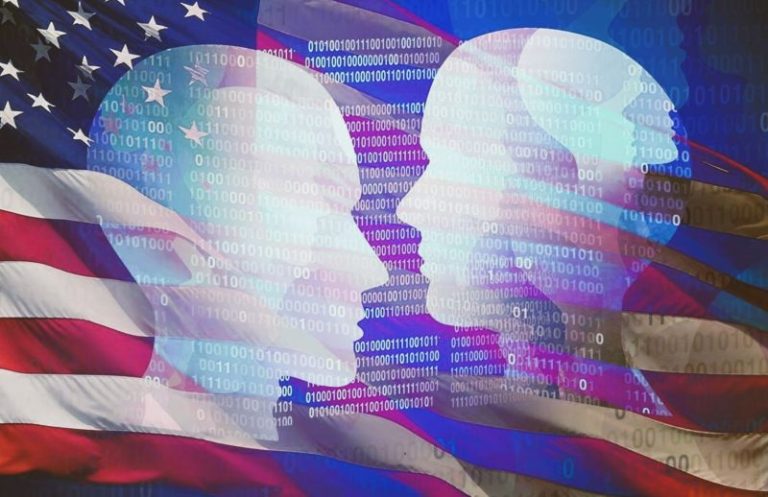

The challenge will be to ensure that the leap from drafting memos to influencing policy is deliberate, transparent, and subject to rigorous review.

By Matthew A. McIntosh
Public Historian
Brewminate
A Federal AI Comes into View
The U.S. government has unveiled a new AI platform for its own workforce, called USAi. Marketed as a secure, centralized system, USAi offers federal employees access to generative AI tools from major commercial providers such as OpenAI, Anthropic, and Google at heavily discounted rates, in some cases, as low as one dollar for the first year. Its purpose is to give civil servants a sanctioned environment to experiment with and deploy AI for their daily work without risking leaks of sensitive information to public systems.
This is not simply a technology procurement exercise. USAi represents the government’s acknowledgment that artificial intelligence has moved from the periphery of administrative work into its core. Where the private sector has raced ahead with generative tools for drafting documents, summarizing reports, or analyzing data, much of the federal workforce has been left to experiment unofficially, often without clear security protocols. USAi seeks to close that gap by formalizing access and oversight.
How USAi Works in Practice
The General Services Administration (GSA) is administering the platform, framing it as a “secure playground” for AI in public service. Federal workers can log into USAi and select from a menu of tools, each hosted within a government-managed environment that anonymizes data and prevents retention of sensitive inputs by the AI vendors.
Officials say the system will allow workers to perform routine tasks more quickly: drafting policy briefs, generating summaries from large regulatory filings, creating training materials, or even producing code snippets for agency software. The platform also includes templates and guidance to help staff choose the right tool for the task, minimizing both inefficiency and risk.
While the operational details sound straightforward, they mask a more ambitious intention. USAi is not just about providing tools; it is about shaping how public servants learn to think with, and through, artificial intelligence. The platform includes usage analytics and training modules so agencies can monitor adoption and refine their AI strategies over time.
The Promise and the Pitfalls

Supporters of the initiative see USAi as a practical step toward modernizing a sprawling bureaucracy that is often accused of lagging behind the private sector. The hope is that, by standardizing access to safe AI systems, agencies will be able to reduce bottlenecks, improve document quality, and free employees from repetitive administrative burdens.
Yet the move also invites skepticism. The very features that make AI useful (speed, fluency, and pattern recognition) can also make it prone to confident error. In high-stakes domains like immigration processing, environmental regulation, or public health, a flawed AI-generated output could have real consequences if it slips through without adequate human review. The government’s track record on technology rollouts offers a cautionary backdrop. From botched healthcare websites to unwieldy case management systems, there is a history of tools being deployed before they are fully integrated into the workflows and cultures of the agencies meant to use them.
Guardrails and Governance
The GSA has emphasized that USAi is launching with security and compliance at the forefront. Data entered into the system will not be stored by commercial AI providers. Agencies will retain the ability to set their own internal guidelines for acceptable use, and the platform is designed to log all interactions for audit purposes.
Still, experts in technology governance point out that security is only one dimension of responsible AI deployment. There are open questions about bias, transparency, and the balance between efficiency and accountability. If an AI system helps draft a policy recommendation, will decision-makers know exactly how much of the language originated from the machine? And if a citizen challenges a decision influenced by AI, will agencies be prepared to explain and justify the process?
The government’s proposed AI Bill of Rights, released in 2022, calls for clear notice and human oversight whenever automated systems are used in public-facing decisions. USAi will be an early test of whether such principles can be upheld in a tool designed primarily for internal administrative work.
Cultural Context and the Question of Trust
Federal agencies are vast ecosystems of policy specialists, analysts, lawyers, and field staff, each with their own professional norms. Introducing a centralized AI platform into that ecosystem will not be frictionless. Some workers will see it as a long-overdue modernization; others may regard it as a shortcut that undermines the craft and deliberation of their work.
Trust in AI is not built solely on technical safeguards. It depends on whether employees believe the system understands the context of their work, whether supervisors treat AI outputs as suggestions or as default answers, and whether mistakes are met with correction rather than quiet adoption.
There is also a public trust dimension. The federal government, unlike a corporation, is accountable to every citizen. A misstep involving AI could quickly become a political flashpoint, especially in an environment where the role of technology in governance is already a subject of fierce debate.
A Measured Rollout or a Gateway?
For now, USAi is being described as a pilot, a controlled introduction that will expand if it proves useful and safe. But the infrastructure being built could serve as the foundation for much broader AI integration in government. If early use cases focus on low-risk administrative tasks, the temptation will be strong to apply the system to more substantive policy analysis or even decision support.
The challenge will be to ensure that the leap from drafting memos to influencing policy is deliberate, transparent, and subject to rigorous review. As with many technological shifts, the first steps may seem modest, but the trajectory can change quickly once the tools are in place and the workforce grows accustomed to them. USAi is both a sign of the times and a test of institutional restraint. The federal government is staking a claim that artificial intelligence can be made safe, useful, and accountable within the unique demands of public service. Whether that claim holds will depend less on the algorithms themselves than on the judgment of the people, and institutions, that choose how to use them.
Originally published by Brewminate, 08.20.2025, under the terms of a Creative Commons Attribution-NonCommercial-NoDerivatives 4.0 International license.


